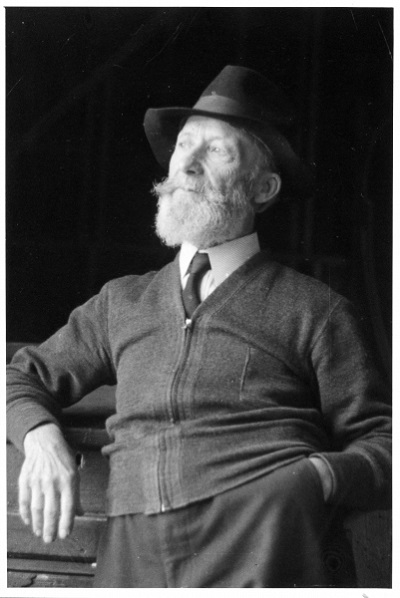
Osias Leduc, born on October 8, 1864, in Saint-Hilaire, Quebec, stands as one of Canada's most significant and revered painters. His life and work embody the spirit of Quebec's cultural heritage, and his contributions to Canadian art have left an indelible mark on the nation's artistic landscape.
Early Life and Artistic Beginnings
Leduc's journey into the world of art began in his hometown, where he was first introduced to painting through church decoration. His early mentor, Luigi Cappello, an Italian painter known for his work in Quebec's churches, played a crucial role in shaping Leduc's artistic foundations. Under Cappello's guidance, Leduc participated in the decoration of Saint-Paul l'Ermite church. This experience not only honed his technical skills but also instilled in him a deep appreciation for religious art, a theme that would persist throughout his career.
Leduc's association with Adolphe Rho further solidified his reputation as a skilled church decorator. One of his notable early works was a copy of Raphael's "Transfiguration," created for the church of Saint-Jean-in-Montana, Jerusalem. Although this painting was a commission given to Rho and signed by him, it showcased Leduc's exceptional talent.
Self-Taught Mastery and Early Achievements
Unlike many of his contemporaries, Leduc was largely self-taught, relying on keen observation and relentless practice to develop his craft. By the age of 23, he was already producing remarkable still life studies, often bathed in the warm glow of candlelight or illuminated by distant windows. One of his early masterpieces, "Les Trois Pommes," exemplifies his ability to capture the delicate interplay of light and shadow, a hallmark of his style.
Leduc's work quickly gained recognition, and in 1892, he won a prize at the Art Association of Montreal's annual show for the best work by an artist under 30. This achievement marked the beginning of a long and illustrious career.
Influence of French Impressionism and Return to Canada
In 1897, Leduc embarked on a transformative journey to France, where he was exposed to the works of lesser-known Impressionists such as René Ménard, Alfons Mucha, and Le Sidaner, as well as the religious art of Maurice Denis. This experience had a profound impact on his artistic style. Upon his return to Canada, he applied the techniques he had learned in France to his work, infusing his paintings with a unique blend of impressionistic light and a deeply personal, almost surreal, vision of nature.
Jean René Ostiguy, a noted art historian, observed that Leduc's interpretation of French Impressionism was distinct. For Leduc, light became a symbol of an ideal world, a way to express his reverence for all living things. His work, while rooted in traditional techniques, possessed a poetic quality that set it apart from the more conventional modern art of his time.

The Poetic and Spiritual Dimensions of Leduc's Art
Leduc's work is often described as a reflection of his inner spirituality and moral integrity. Gilles Corbeil, an art critic, noted the extraordinary care Leduc devoted to every aspect of his paintings. From the preparation of the canvas to the final brushstroke, Leduc approached his art with a deep sense of responsibility and reverence. This meticulous attention to detail is evident in his still life studies, which often feature simple objects such as apples, bread, or books, rendered with a tenderness that elevates them to the level of sacred relics.
Throughout his life, Leduc painted only about 20 still life studies, each one a testament to his ability to infuse everyday objects with a sense of dignity and grace. His work has been compared to that of Jean-Baptiste-Siméon Chardin, the French master of still life, and Willem Claesz Heda, the Dutch painter known for his austere compositions.
A Prolific Career in Church Decoration
While Leduc is celebrated for his still lifes and portraits, the majority of his work was dedicated to church decoration. Over his lifetime, he completed more than 150 paintings for approximately 28 cathedrals, churches, and chapels across Quebec. Some of his most notable works include the mural of Saint Charles Borromée in Lachenaie, the large painting of Christ descended from the cross for Notre-Dame-de-la-Paix in Verdun, and the Martyrdom of Saint Julie for the church of Sainte-Julie in Chambly.
Tragically, 19 of his works were destroyed in a fire at the church of Rougemont in 1930, a significant loss to Quebec's cultural heritage.
Recognition and Legacy
Leduc's contributions to Canadian art were widely recognized during his lifetime. In 1916, he was elected an Associate of the Royal Canadian Academy, and in 1938, he received an honorary doctorate from the University of Montreal. His works have been exhibited in major galleries and museums across Canada, including the Montreal Museum of Fine Arts and the National Gallery of Canada.
In his later years, Leduc remained active in the art world, overseeing church decoration projects well into his 90s. He passed away on June 16, 1955, in Saint-Hyacinthe, Quebec, at the age of 91, leaving behind a rich legacy of artistic achievement.
Conclusion
Osias Leduc's work is a testament to the power of art to elevate the everyday to the realm of the sublime. His paintings, whether religious murals or intimate still lifes, reflect a deep spiritual connection to the world around him. Leduc's influence on Canadian art, particularly in Quebec, is profound and enduring, making him one of the most important figures in the history of Canadian painting. His legacy continues to inspire new generations of artists, who seek to capture the same sense of reverence and beauty that Leduc brought to his work.
Browse our collection of Canadian paintings for sale at the Canadian Classic Fine Art gallery, The best place to buy a painting online. We provide free shipping anywhere in Canada and the United States. Our Montreal art gallery sells paintings online exclusively and have a 14 days return policy.
